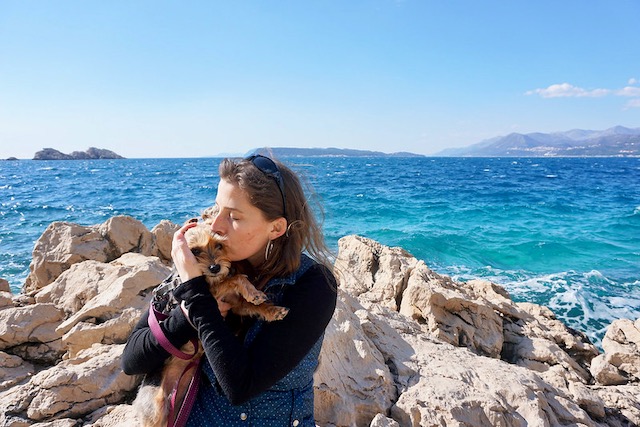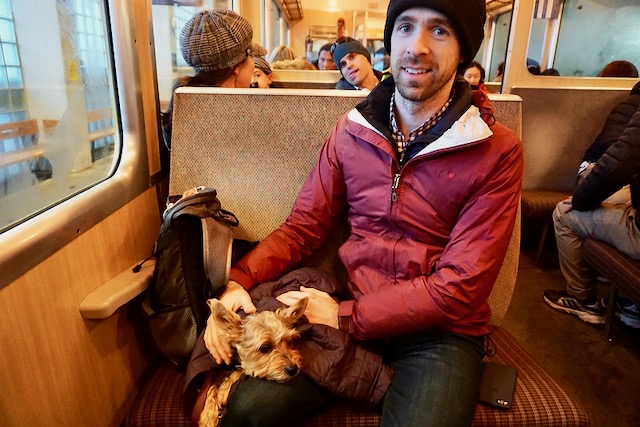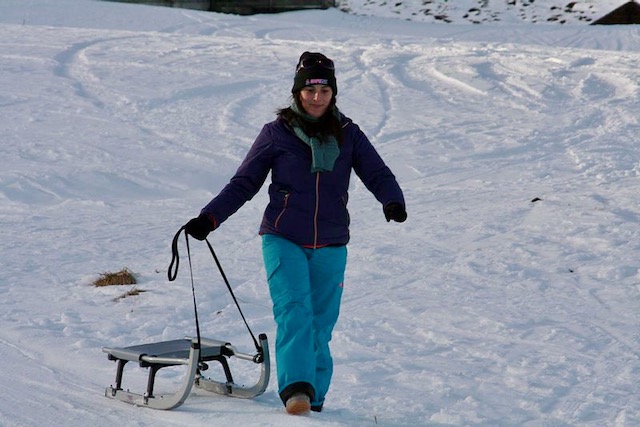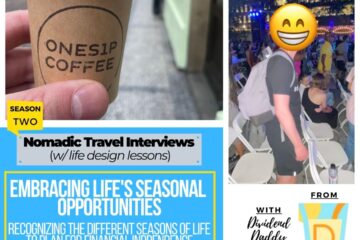
This interview is part of our interview series, where we curate stories of regular people that decided to design a life they love. (click here to learn more).
Gigi from GigiGriffis.com
Some links to the products mentioned below are affiliate links, meaning that if you click and make a purchase, we (Nomad Numbers) may receive a commission at no additional cost to you. For more information please review our disclaimer page.

- Can you introduce yourself?
Gigi: I’m Gigi – a writer and content strategist who has been on the road for over eight years. I’m originally from the US, though I spend most of my time in Europe these days. I’ve been truly nomadic, with no home base, for most of that time, though I have also had long-stay visas in both Switzerland and Estonia (where my partner and I are currently loosely based) for at least a year each.
I’m an outdoorsy foodie, an advocate of slow travel, and a nomad with a dog in tow (yep, you read that right: my Yorkie-Schnauzer mix Luna has been to something like 30 countries now). So usually you’ll find me staying in one place for anywhere from one to six months and spending my non-working time hiking, cycling, browsing fresh markets, and seeking out a location’s best food, all with a little dog at my heels or in my dog-carrier backpack.
2. What does a typical day in your life look like for you today? How does it differ from your life before?
Gigi: Nowadays, I wake with the sun, usually somewhere between 5 a.m. and 7 a.m., and spend my mornings (which are my most focused, productive time) working on client projects or whatever passion project I’ve got going (currently: a young adult historical novel based on an Eastern European myth!).
I typically finish work around lunchtime, make myself a small lunch, and then spend the afternoon either working on passion projects, going for long walks, cycling, exploring a new place, or curled up with a good book on a patio, balcony, or cozy chair.
In the early evenings at least once a week, I come back to my proverbial desk for client calls. Most of my clients are on the west coast of the US, which means we’ve got a 10-hour time difference here in Estonia (9 hours when I’m somewhere like Italy or France), so my calls tend to be at six or seven at night.
Since I typically try to be in bed around 9 p.m., after calls you’ll mostly find me reading, listening to science podcasts with my partner, or watching a low-key movie to wind down.
I work part-time for mental health reasons, so this schedule varies a bit day to day (with me working anywhere from two to four days per week). I always take Fridays off and generally try to stay away from screens/do something outdoors. And on the weekends, my partner and I explore whatever location we’re in or cozy up indoors, depending on the weather.
My life was very different before. In 2012, before I left to travel, I’d wake up, make myself breakfast, and work five days a week in my home office.
Self-employment was still pretty new to me and I was working long hours and struggling with burnout. I’d also been diagnosed with depression and anxiety and was struggling to learn how to manage them, especially with the long hours I was working.
This meant I was pretty exhausted whenever I wasn’t working and spent a lot of my free time just trying to recover – reading books, going for walks, occasionally having dinner with friends, or going to local concerts. I always loved the outdoors, but it was actually rare for me to have the energy to get out to the nearby mountains.
Life design journey
3. What inflection point led you to decide to change your life trajectory?
It might sound dramatic, but I left to save my life.
Gigi: From 2009 to 2012, I was struggling with severe depression and trying desperately to climb out of the numb, exhausted, burned-out place I was in. I started therapy, went on antidepressants, adopted my dog, quit my stressful job to go freelance. And then, one day, I realized something:
If I was going to be depressed, I’d rather do it against a backdrop of French beaches or Italian cobblestone old towns than in my little Denver rental.
Gigi Griffis
I didn’t think travel would be the answer to depression (it isn’t), but I did think it’d be a better life for me. I did think I needed a change. I did think I needed to do something for myself. So, about eight months after that tipping point, I ditched my permanent address, packed my life into bags, and boarded a plane with a one-way ticket to Europe.
4. What were some of the limiting beliefs that hold you back initially?
Gigi: I was horribly afraid of time differences! I was still working full-time, still trying to build up a new business and make ends meet as a relatively new freelancer, and I was scared that going to Europe (where my heart really, really wanted to go) would frustrate my clients and leave me without income.
Surprisingly, the time difference turned out to be a good thing! My clients are asleep when I’m doing most of my work, which means no interruptions. It increased my productivity by leaps and bounds. And clients don’t seem to mind having mostly 9 a.m. calls, so my fears were unfounded.
5. What did you do to prepare the transition to this new destination and how did you do it?
Gigi: I’m extremely risk-averse, so I did a *lot* of planning and gave myself a long runway for the transition. I started planning about eight months before I left, with a planned departure date that coincided with the end of my lease. I gave my landlord plenty of notice. I got my ticket to Europe. I booked a month in a guesthouse in Edinburgh. And I spent those months building up client relationships, getting rid of most of what I owned, and starting to research the places I wanted to go first.
I also did a lot of additional research and planning in order to take the dog with me. (Because leaving her behind was 1000% never an option.) For travels in Europe, this meant getting her microchipped with an EU-recognized type of microchip months before leaving, updating her rabies shot after the new microchip, getting her an airline-approved carrier and helping her get used to it, making sure I found dog-friendly accommodations and understanding what the rules were for dogs on planes, trains, etc.
That was, by the way, another thing I thought would be harder than it actually was. Turns out, traveling Europe with a small dog is actually a lot easier than traveling the US with a dog! Is it more complicated than traveling without a dog? Of course. But is it as difficult as I imagined? Not even close. It mostly involves additional vet visits for paperwork before crossing new borders and a little extra research on which airlines will take a small dog in-cabin.
6. Traveling with a dog is quite impressive! What advice / resources do you have for people that think traveling with a dog is impossible and want to get started?
Gigi: There are actually a *lot* of people traveling with their dogs these days to just about every corner of the globe. I’ve talked to with-dog travelers overlanding Africa in a van, exploring the coasts of Sicily, even cycling across whole countries. My dog has been to about 30 countries, herself, traveling by everything from train to plane, bus to car, bicycle to distance hike
The big key is that traveling with a dog isn’t impossible, but it is different. So be prepared to do some extra planning, travel a little slower, carry more gear, etc. For most border crossings, you’ll need vaccine certificates and vet approvals. Finding accommodation takes on the extra step of checking with hosts or hotels about whether they welcome pets (and if they charge a fee). Slow travel (which is, frankly, nicer anyway) becomes more essential when there are extra steps involved in crossing borders. And there are some places I choose not to go because I can’t take Luna without a quarantine (Australia, for example).
For me, these trade-offs are not only worth it, they’re essential. Because when I adopted my dog, that was a decision I made for life. ‘Til death do us part. So I came into my nomadic planning knowing that I was only going if she could go – and I’ve planned my adventures around that. It’s one of the reasons I spend so much time in Europe. It’s so incredibly dog-friendly here.
For answers to common questions about traveling with a dog, I recommend checking out Montecristo Travels and the Animal Travelers group on Facebook.
The big key is that traveling with a dog isn’t impossible, but it is different
Gigi Griffis
7. Once on the journey, what were some of the biggest wins you realized? What were the challenges you had to face along the way?
Gigi: Traveling didn’t cure my depression, but there was something really powerful about choosing to do something that was just for me in the midst of the hardest time in my life. It gave me space to breathe and think and do what I wanted without many external pressures. And that was incredibly healing.
When I left to travel, I gave myself permission to change my mind anytime. If it wasn’t all I thought it would be, if I missed friends, if work was too hard with the time difference, I could buy another one-way ticket and hightail it back to Denver, I promised my anxious heart. Instead, after just a couple months of travel, I knew that this was the right long-term choice for me. I returned to the US to sell my car (which I’d hung onto just in case), visit friends, and then take another one-way journey back to Europe, this time with no plans to return anytime soon.
In the years that followed, I met my partner, reduced my working hours, and had tons of adventures. I’ve cycled across France from the Swiss border to the Atlantic Ocean on the Eurovelo 6 cycle trail. I’ve hiked to the top of a lofty mountain called Schilthorn in the Swiss Alps (my highest altitude hike). I’ve lived in artsy neighborhoods in Paris, quiet Italian hilltowns, Swiss mountain valleys, and a top-floor apartment overlooking Germany’s gorgeously eerie Black Forest.
We’ve also decided to move to Europe long-term (something that’s currently in the works). We plan to set up a true home base sometime in the next year or two (depending entirely on COVID, which has, of course, thrown a wrench in many visa processes).
As far as challenges go, COVID was the big one. We were in central Italy when the northern quarantine went into effect. We knew it was going to expand, so within 48 hours we had packed our bags, taken a train to Rome, booked an apartment in Tallinn, and boarded a flight back to Estonia to wait out the crisis. We were so glad to have our Estonian visas when that happened.
Cost of living
8. How much yearly expense did you have before and after this change in lifestyle?
Gigi: My goal is to spend less than $2,000 per month (so, less than $24,000 per year) on day-to-day expenses like rent, groceries, trains, insurance, vet visits, etc. That does not include business expenses or large one-time expenses like replacing my computer or dealing with an unexpected medical bill.
For those day-to-day expenses, I track my spending on a monthly basis and publish those budgets for others hoping to follow in my footsteps.
While my goal is to stay under $2,000 per month, my average is actually quite a bit lower. So when I say $2,000, that’s really me rounding up. I recently did the math on the 30 real Europe travel budgets I’ve published on my blog (including several months over budget in places like Paris and Biarritz) and the monthly average came in at $1,637.
| Category | Description | Cost per person and per month |
|---|---|---|
| Accommodation | Anything you pay toward keeping a roof over your head (ie. rent, internet, water, utilities…) | $400 – 1000 |
| Alcohol | Anything related to alcohol you purchase | I include this in my food budget |
| Groceries | Anything related to the groceries you get to cook at home | $300 – 400 |
| Dining out / Take-out | Anything related to what you spend when dining outside of your home. | $100 – 300 |
| Activities / Entertainment | Anything you pay related to ‘fun money’ (ie. park fees, outdoor activity, AirBnB experience…) | $0 – hiking and cycling are usually free |
| Health Care | Any cost related to treatment you are receiving on a given location. | $20 – 50 |
| International Health / Travel Insurance | This is health.travel insurance that your purchase to get you covered outside of your home country | $190 |
| Local Transportation | Anything related to transportation within the boundary of the location you are staying at. | $0 – 50 |
| International Transportation | Anything related to transportation to go from one location to another. | $0 – 500 |
| Visa | Any cost related to a visa to stay within a given country. | These are typically one-time costs. I probably spend $25 per year or so. |
| Living expenses | Anything else that you are spending money on to live in a specific location that can’t fit anywhere else (ie. Haircut, Netflix, cell phone…) | Varies |
| Monthly total | $2,000 or less | |
| Yearly total | $24,000 or less |
Since I’m traveling with a dog, I also deal with vet bills, supplies, food, additional airline fees, and other dog-related expenses. The good news is that most countries are far cheaper than the US when it comes to things like vet visits. In Latvia, a vet emergency ran us $100.
In Croatia, a similar emergency cost about $150. In the US, just the bloodwork in a non-emergency situation would have cost over $200 and a similar emergency could have easily racked up $1,000 in bills.
My goal is to spend less than $2,000 per month (so, less than $24,000 per year) on day-to-day expenses like rent, groceries, trains, insurance, vet visits, etc
Gigi Griffis
9. What strategies have you used to reduce your expenses? And what strategies have you used to fund your lifestyle?
Gigi: We are slow travelers, so our lifestyle is automatically much cheaper than nomads who travel faster. We typically stay in a location for 1 – 3 months (sometimes longer). This means transportation costs stay low, since we rarely fly and only take long-distance trains every few months. It also keeps housing costs low, as most holiday rentals offer discounts for stays of over a month.
Both myself and my partner also love the outdoors, which keeps our entertainment budgets at nearly $0 each month. We’re happiest when we’re out cycling between castles or hiking to a mountain peak for a picnic. This is less strategy and more just us embracing how much simple, free things already make us happy.
As for funding our lifestyles, as I mentioned, I’m a freelance copywriter and content strategist. My income is pretty steady whether I’m in the US or abroad, so it’s easy to keep traveling since my lifestyle abroad is much cheaper than staying in the states (mostly due to the excessive cost of US healthcare and the cost of owning a car, which I definitely don’t have to worry about in Europe).
Similarly, my partner is a programmer and tech podcaster/webinar host, so traveling was an easy transition, as he’s always been able to work from anywhere with Wi-Fi and a laptop.
We are slow travelers, so our lifestyle is automatically much cheaper than nomads who travel faster.
Gigi Griffis
Lessons, tips & advices
10. If you had to do it again, what would you do differently?
Gigi: Not a thing! I gave myself plenty of time to plan. I chose the destinations my heart was longing for. And I’ve done it all on a budget from the start. There are plenty of things I’d change about my life, but there’s nothing I’d change about going nomadic.
11. What advice do you have for others who are considering going through a life design exercise?
Gigi: It’s not all or nothing. I think one of the biggest things that holds us back from making a life change is that we feel like we can’t go back. But that’s seldom true. If you hate traveling, you buy a ticket back to your home country. If you hate freelancing, you stick it out for a little while while looking for your next full-time job. If you hate a destination, you leave. The leap is less scary when you start reminding yourself that you can always go back.
It’s not all or nothing!
Gigi Griffis
12. What is one resource (blog, podcast, book beside your own) you recommend for those that want to design their own life?
Gigi: Doctor in Denim. The author is a close friend of mine who is a whiz at paying down debt, designing work to support your life (and not the other way around), and helping you question the status quo cultural assumptions about what it means to live a good life. She’s brilliant and everyone should be reading her.
Looking ahead
13. What is next for you?
Gigi: We’re currently waiting to hear back from Switzerland on our applications for long-stay visas! I lived in Switzerland for about two years midway through this journey and we’ve decided we’d like to go back and start to build a community and a home base (though I imagine we’ll keep traveling often).
Rapid-fire questions
We like ending every interview asking some fun rapid-fire questions to our guests
| What is your superpower & why? | I’m an A+ listener, which means I tend to make friends with strangers easily and communicate well even if I’m trying to communicate with someone without a shared language. |
| What is your favorite travel destination & why? | The Swiss Alps. There’s just no other landscape like that. |
| What’s something you can never live without? | My dog. She genuinely saved my life in the worst depressive episode I’ve had. She’s the most important person in my life. |
| What’s the best piece of advice you’ve received? | Life isn’t black and white, good and bad, all or nothing. There aren’t nearly as many binaries as we think. |
Thank you so much Gigi for sharing your transformational life design journey with us. It is quite inspiring to see how you took control of both your freelance work and your mental health and you have now taken much better control of your free time to fully enjoy Europe (except during COVID19 ). As for now, we hope that you, Chad (& Luna) will be able to get your long term residency in Switzerland (we are trying to do the same here in Taiwan) and we personally hope that our path will cross once we come back to Europe!

If you want to know more about Gigi, you can find her on the following platforms:
- Blog: The Ramble
- Facebook: @Gigigriffis
- Twitter: @Gigigriffis
Interview resources
Don’t forget to check these additional resources that are related to this interview:
Our Bottom Line
Here are the main lessons we took away from this interview with Gigi:
- Lesson 1 – “We are slow travelers, so our lifestyle is automatically much cheaper than nomads who travel faster”. – By staying between 1 – 6 months in a single location, Gigi can keep her cost pretty low (thanks to long term rentals). Also by not moving that often, she doesn’t have to deal with additional transportation costs and stress related to packing/unpacking. And because she has set up a location independent life, if she wants to reduce her expenses further, she can relocate to a lower cost of living country.
- Lesson 2 – “Traveling did not cure my depression but there was something really powerful about choosing to do something that was just for me in the midst of the hardest time in my life”. – While dealing with anxiety and depression, Gigi made the scary (yet well-planned) jump into the unknown by taking a one-way flight to Europe. Choosing to do something so true to herself and her love for travel and Europe was a pivotal moment that led her to a more balanced, healthy life where she better understands and prioritizes her mental health.
- Lesson 3 – Don’t ditch your dog!
You don’t have to choose between your fuzziest family member and your travel dreams. Travel with a dog is different but absolutely possible (and deeply fulfilling and grounding).
Sometimes we need to hear about others making unconventional decisions before we can have the confidence to make our own. If you have (or are on a path to) an unconventional journey to improve your life that has a nomadic component to it and is interested to share it, please reach out to us as we would love to consider your story for our blog.















3 Comments
Our Freedom Years · September 15, 2020 at 12:26 pm
When I first saw the headline I thought, well, this person sounds very relatable. Turns out it’s our favourite human-canine travelling duo! Of course, we’re quite familiar with your backstory from obsessing over your blog but it was great to read this fresh take. Good luck with the Swiss visas! You’ve almost inspired us to consider northern European travel in the winter — almost.
Gigi · September 15, 2020 at 3:11 pm
Hey! Thanks for recommending me for the interview!
David @iretiredyoung · September 20, 2020 at 10:12 am
Your answer to question 11 included “I think one of the biggest things that holds us back from making a life change is that we feel like we can’t go back”. That’s great advice. I’ve started to realise this in the last 4 or 5 years and it’s made a huge difference.
I find it interesting to hear how many people say how lucky we are. When we worked overseas, they might say “I’d love to do that” and the answer is that they could, if they really wanted to and took the steps to do it. The reality is that the vast majority are too nervous or scared of change to try it.